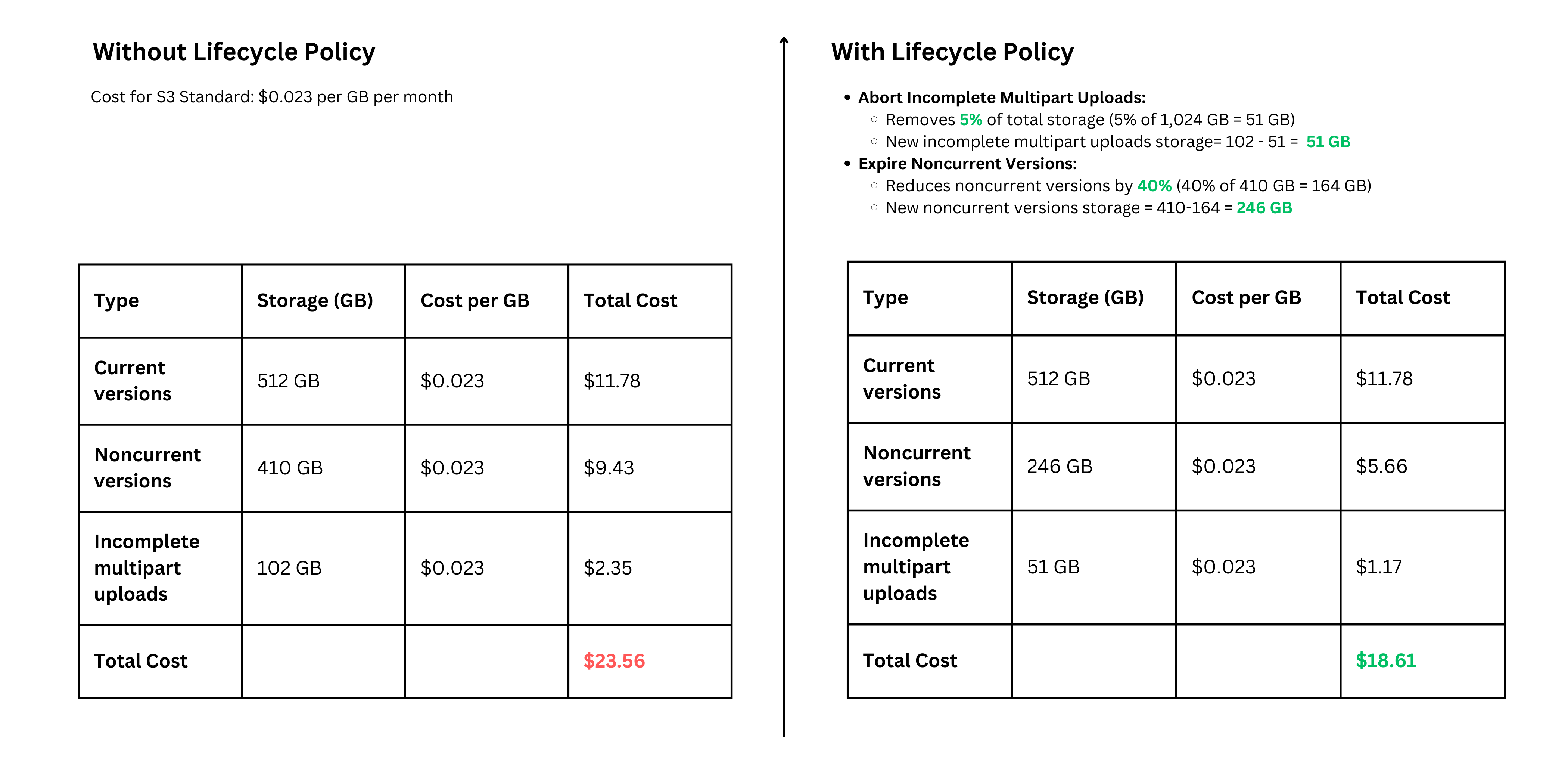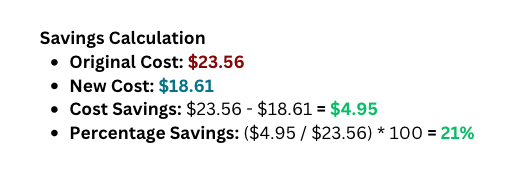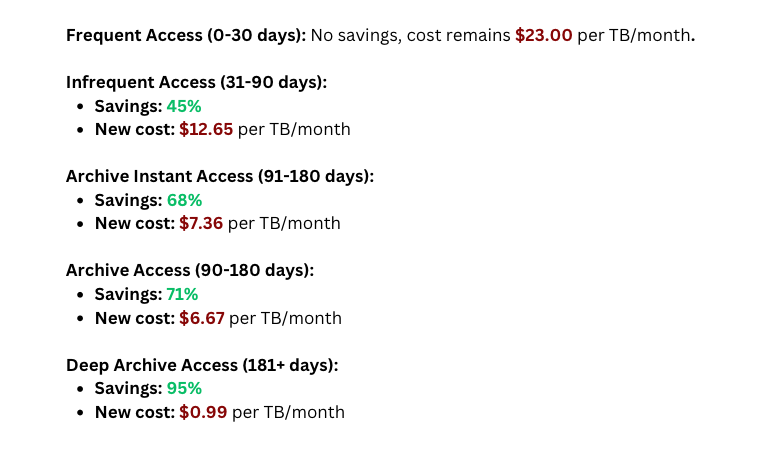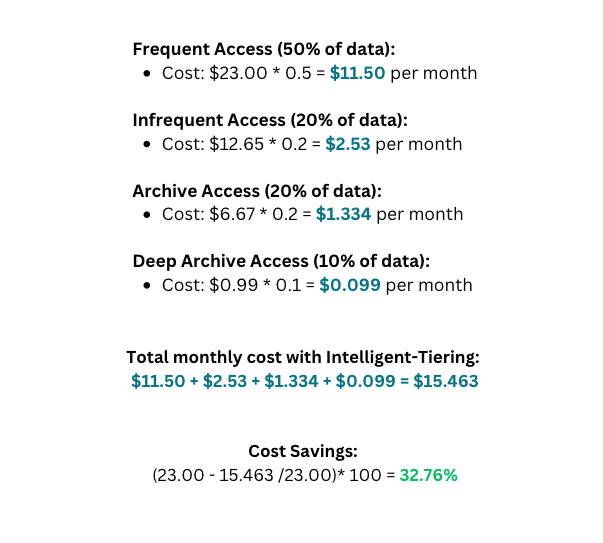AWS Recommendations
Recommendations help kickstart your journey with governance. Essentially, Harness run certain policies behind the scenes to generate recommendations for your governance-enabled AWS accounts. These policies not only help to cut costs but also increase the efficiency of your system. On the Governance Overview page, Harness showcases recommendations that will benefit you to save costs on associated resources. You can click on any recommendation to view its details.
Listed below are the custodian policies which are used to generate recommendations that Harness offers for AWS. Along with each policy, you can also find their respective descriptions, the logic behind savings computation and the permissions required to generate or apply these recommendations.
Recommendation: delete-unattached-ebs
Description: Delete all ebs volumes which are unattached
Policy Used:
policies:
- name: delete-unattached-ebs
resource: ebs
filters:
- Attachments: []
- State: available
actions:
- delete
Savings Computed: The policy identifies a list of resources on which potential savings are calculated by summing up cost of each resource for last 30 days.
Permissions Required:
- Dry Run:
ec2:DetachVolumeec2:DescribeVolumes
- Run Once:
ec2:DetachVolumeec2:DeleteVolumeec2:DescribeVolumes
Recommendation: elb-low-request-count-list
Description: List ELBs with low request count
Policy Used:
policies:
- name: elb-low-request-count-list
resource: elb
description: List ELBs with low request count
filters:
- type: metrics
name: RequestCount
statistics: Sum
days: 7
value: 7
missing-value: 0
op: less-than
Savings Computed: The policy identifies a list of resources on which potential savings are calculated by summing up cost of each resource for last 30 days.
Permissions Required:
-
Dry Run:
cloudwatch:GetMetricDataelasticloadbalancing:DescribeLoadBalancers
-
Run Once:
cloudwatch:GetMetricDataelasticloadbalancing:DescribeLoadBalancers
Recommendation: migrate-gp2-to-gp3-ebs-volumes
Description: Migrate gp2 volumes to gp3
Policy Used:
policies:
- name: migrate-gp2-to-gp3-ebs-volumes
resource: ebs
filters:
- VolumeType: gp2
- modifyable
actions:
- type: modify
volume-type: gp3
Savings Computed: The policy identifies a list of resources on which potential savings are calculated by summing up cost of each resource for last 30 days. Then, 20% of that sum is taken as the savings.
Permissions Required:
- Dry Run:
ec2:DescribeVolumeAttributeec2:DescribeVolumesModifications
- Run Once:
ec2:DescribeVolumeAttributeec2:ModifyVolumeAttributeec2:DescribeVolumesModifications
Recommendation: delete-snapshot-with-no-volume
Description: Delete snapshots with no volumes
Policy Used:
policies:
- name: delete-snapshot-with-no-volume
description: Find any snapshots that do not have a corresponding volume.
resource: aws.ebs-snapshot
filters:
- type: volume
key: VolumeId
value: absent
actions:
- delete
Savings Computed: The policy identifies a list of resources on which potential savings are calculated by summing up cost of each resource for last 30 days.
Permissions Required:
- Dry Run:
ec2:DescribeVolumes
- Run Once:
ec2:DescribeVolumesec2:DeleteSnapshot
Recommendation: stop-unused-rds
Description: Stop unused RDS database
Policy Used:
policies:
- name: stop-unused-rds
resource: rds
description: Stop unused RDS database
filters:
- type: value
key: DBInstanceStatus
value: available
- type: metrics
name: DatabaseConnections
statistics: Sum
days: 7
value: 0
op: equal
actions:
- stop
Savings Computed: The policy identifies a list of resources on which potential savings are calculated by summing up cost of each resource for last 30 days.
Permissions Required:
- Dry Run:
rds:DescribeDBInstances
- Run Once:
rds:DescribeDBInstancesrds:StopDBInstance
Recommendation: elb-delete-unused
Description: Delete unused ELB
Policy Used:
policies:
- name: elb-delete-unused
resource: elb
filters:
- Instances: []
actions:
- delete
Savings Computed: The policy identifies a list of resources on which potential savings are calculated by summing up cost of each resource for last 30 days.
Permissions Required:
- Dry Run:
elasticloadbalancing:DescribeLoadBalancers
- Run Once:
elasticloadbalancing:DescribeLoadBalancerselasticloadbalancing:DeleteLoadBalancer
Recommendation: release-unattached-eips
Description: Release unattached Elastic IPs
Policy Used:
policies:
- name: release-unattached-eips
resource: aws.elastic-ip
filters:
- AssociationId: absent
actions:
- release
Savings Computed: The policy identifies a list of resources on which potential savings are calculated by summing up cost of each resource for last 30 days.
Permissions Required:
- Dry Run:
ec2:DescribeAddresses
- Run Once:
ec2:DescribeAddressesec2:ReleaseAddress
Recommendation: under-utilized-elasticcache-cluster
Description: Delete underutilized cache cluster with CPU utilization less than 5% in the last 7 days.
Policy Used:
policies:
- name: under-utilized-elasticcache-cluster
resource: cache-cluster
description: |
Delete underutilised cache cluster with CPU utilisation less than 5% in last 7 days
filters:
- type: metrics
name: CPUUtilization
days: 7
period: 86400
value: 5
op: less-than
actions:
- type: delete
skip-snapshot: false
Savings Computed: The policy identifies a list of resources on which potential savings are calculated by summing up the cost of each resource for the last 30 days.
Permissions Required:
- Dry Run:
elasticache:DescribeCacheClusters
- Run Once:
elasticache:DescribeCacheClusterselasticache:DeleteCacheClusterelasticache:DeleteReplicationGroup
Recommendation: s3-lifecycle-configuration
Description: Configure lifecycle for S3 buckets wherever it is absent which would help to reduce storage spend
Policy Used:
policies:
- name: s3-lifecycle-configuration
resource: aws.s3
description: |
Configure lifecycle for s3 buckets wherever it is absent which would help to reduce storage spend
filters:
- type : value
key : Lifecycle
value : absent
actions:
- type: configure-lifecycle
rules:
- ID: harness-default-lifecycle
Status: Enabled
Filter:
Prefix: ''
Expiration:
ExpiredObjectDeleteMarker: True
AbortIncompleteMultipartUpload:
DaysAfterInitiation: 7
NoncurrentVersionExpiration:
NoncurrentDays: 30
NewerNoncurrentVersions: 6
Savings Computed: To estimate the percentage cost savings from the given S3 lifecycle policies, we need to look at the specific actions and apply some reasonable assumptions. Here's a step-by-step approach:
- Abort Incomplete Multipart Uploads after 7 days:
- Assumption: 5% of all uploads are incomplete and are not cleaned up without this policy.
- Cost Impact: Each incomplete multipart upload that is aborted saves the storage cost of the data uploaded so far.
- Expire Noncurrent Versions after 30 days (keeping 6 versions):
- Assumption: Each object has, on average, 10 noncurrent versions stored. Expiring noncurrent versions after 30 days, keeping only the latest 6, will delete 4 out of every 10 noncurrent versions.
- Cost Impact: Deleting 40% of noncurrent versions reduces the total storage used by these versions.
Example Calculation
Let's assume the following for a single S3 bucket:
Total Storage Used: 1 TB (1,024 GB) in the S3 Standard storage class.
Storage Distribution:
- Current versions: 50% (512 GB)
- Noncurrent versions: 40% (410 GB)
- Incomplete multipart uploads: 10% (102 GB)
Calculations:

Total Savings

References:
Permissions Required:
- Dry Run:
s3:GetLifecycleConfiguration
- Run Once:
s3:GetLifecycleConfigurations3:PutLifecycleConfiguration
Recommendation: s3-intelligent-tiering-configuration
Description: Configure intelligent tiering for S3 buckets wherever it is disabled which would help to reduce storage spend.
Policy Used:
policies:
- name: s3-intelligent-tiering-configuration
resource: aws.s3
description: |
Configure intelligent tiering for s3 buckets wherever it is disabled which would help to reduce storage spend.
filters:
- not:
- type: intelligent-tiering
attrs:
- Status: Enabled
actions:
- type: set-intelligent-tiering
Id: harness-default
IntelligentTieringConfiguration:
Id: harness-default
Status: Enabled
Tierings:
- Days: 90
AccessTier: ARCHIVE_ACCESS
- Days: 180
AccessTier: DEEP_ARCHIVE_ACCESS
Savings Computed:
- Frequent Access Tier: This tier is equivalent in cost to the standard S3 storage, so no savings here.
- Infrequent Access Tier: Data not accessed for 30 days moves here, saving approximately 45% compared to standard S3 storage.
- Archive Instant Access Tier: Data not accessed for 90 days moves here, with savings of up to 68% compared to standard storage.
- Archive Access Tier: If configured, data not accessed for 90 days can move here, offering around 71% savings.
- Deep Archive Access Tier: Data not accessed for 180 days can be moved to this tier, providing up to 95% savings.
Example Calculation
Assume you have 1 TB of data stored in S3 standard storage:

Example Scenario
If 20% of your data transitions to the Infrequent Access tier after 30 days, 20% moves to Archive Access after 90 days, and 10% moves to Deep Archive Access after 180 days, your costs might look like this:

This results in a cost savings of approximately 32.76% compared to keeping all data in standard S3 storage ($23.00 per month vs. $15.463 per month).
References:
Permissions Required:
- Dry Run:
s3:GetBucketIntelligentTieringConfiguration
- Run Once:
s3:GetBucketIntelligentTieringConfigurations3:PutIntelligentTieringConfiguration
Recommendation: delete-underutilized-redshift-cluster
Description: Delete any Amazon Redshift cluster where CPU Utilization has been less than 5% for the last 7 days
Policy Used:
policies:
- name: delete-underutilized-redshift-cluster
resource: redshift
description: |
Delete redshift cluster where CPU Utilization is less than 5% for last 7 days
filters:
- type: metrics
name: CPUUtilization
days: 7
period: 86400
value: 5
op: less-than
actions:
- delete
Savings Computed: The policy identifies a list of resources on which potential savings are calculated by summing up the cost of each resource for the last 30 days.
Permissions Required:
- Dry Run:
redshift:DescribeClusters
- Run Once:
redshift:DescribeClustersredshift:DeleteCluster
Recommendation: delete-redshift-old-manual-snapshots
Description: Delete all redshift snapshots older than 35 days with a lifetime retention period
Policy Used:
policies:
- name: delete-redshift-old-manual-snapshots
resource: redshift-snapshot
description: |
Delete all redshift snapshot older than 35 days with lifetime retention period
filters:
- "ManualSnapshotRetentionPeriod": -1
- type: age
days: 35
op: gt
actions:
- delete
Savings Computed: The policy identifies a list of resources on which potential savings are calculated by summing up the cost of each resource for the last 30 days.
Permissions Required:
- Dry Run:
redshift:DescribeClusterSnapshots
- Run Once:
redshift:DeleteClusterSnapshotredshift:DescribeClusterSnapshots